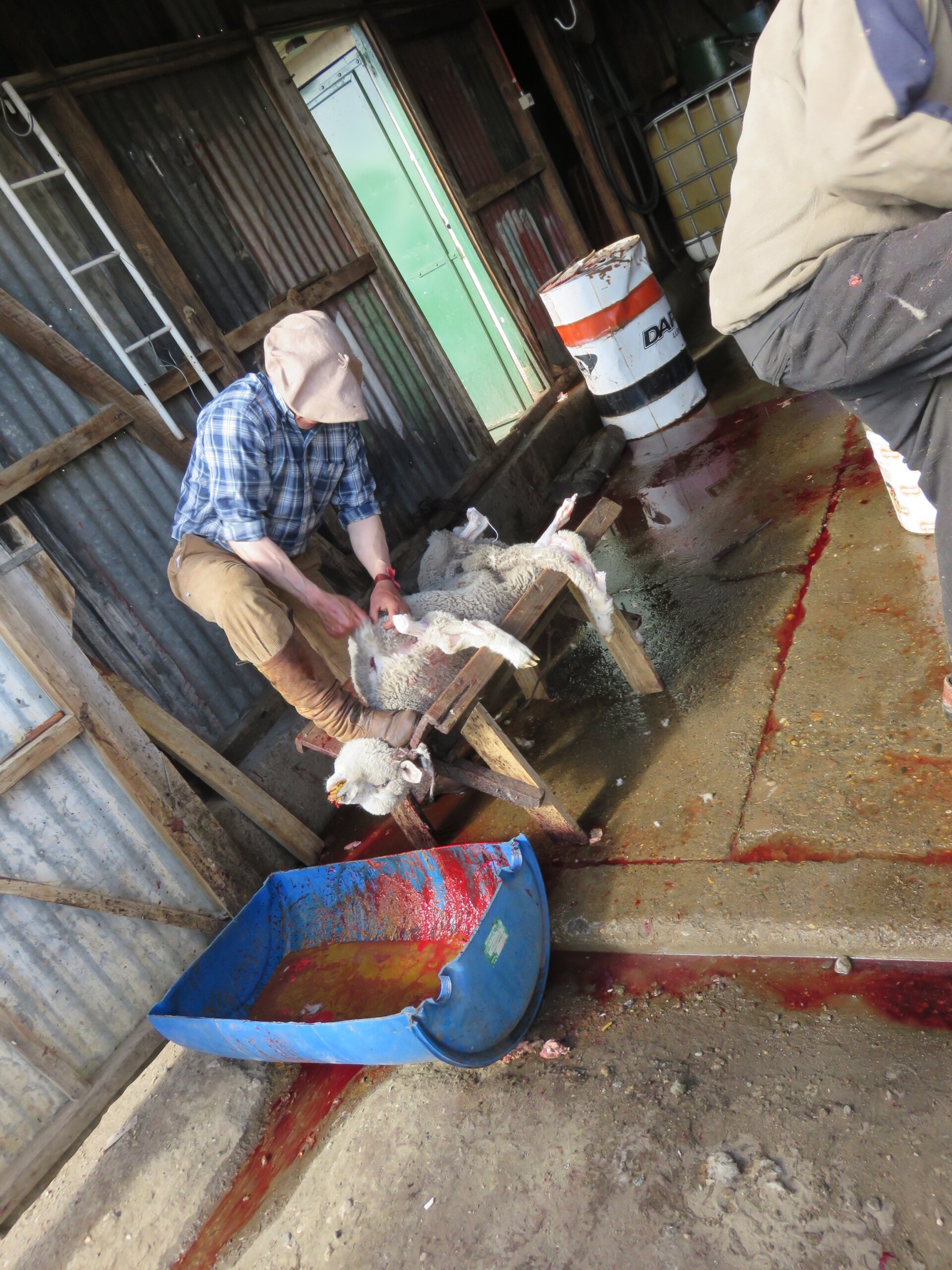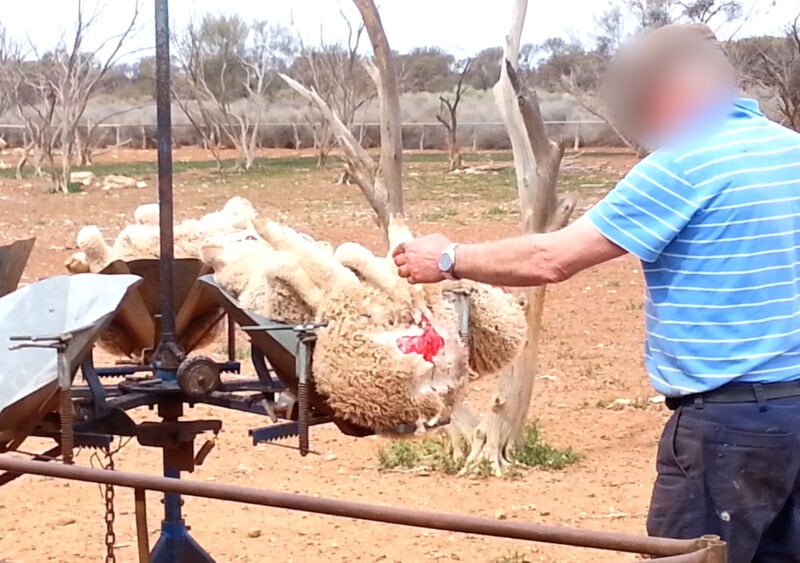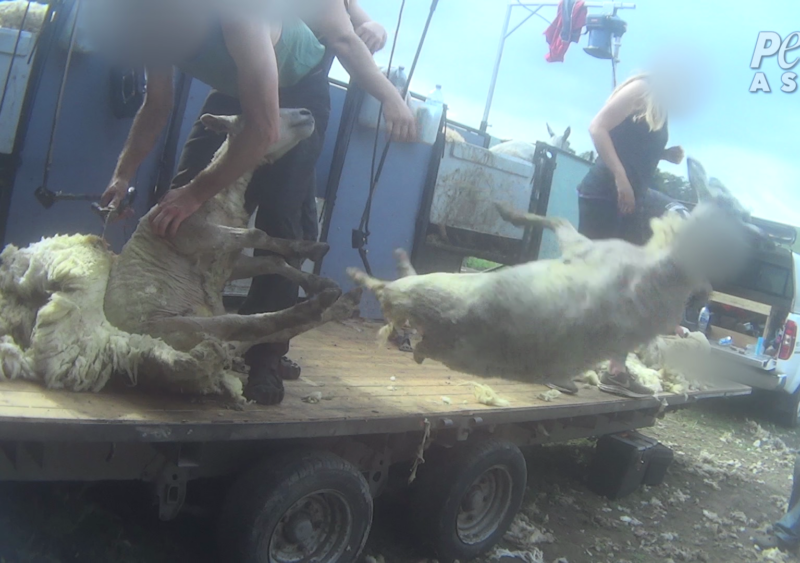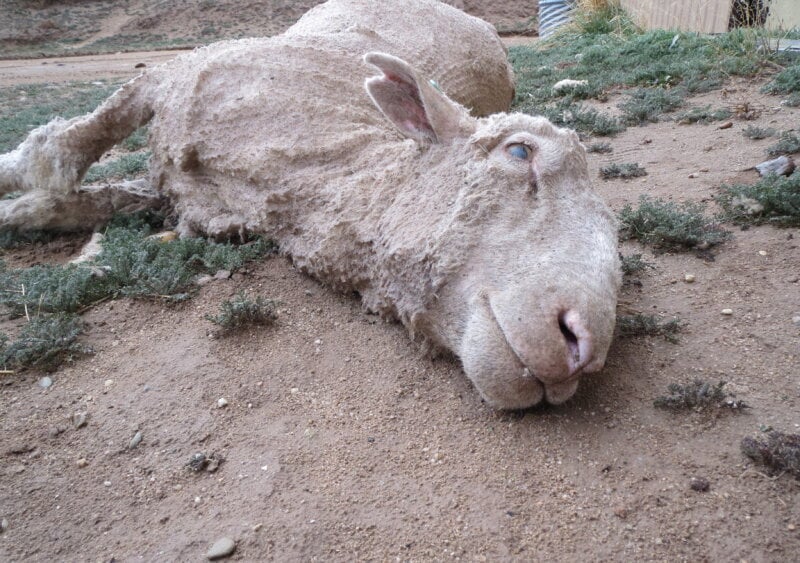South America
2014 – Argentina
In 2014, a PETA Asia investigation revealed what life was like for lambs and sheep used for “responsibly sourced wool” on “sustainable” farms in Argentina supplying outdoor clothing brand Patagonia.
A witness found workers hacking into fully conscious lambs, starting to skin some of them while they were still alive and kicking, and otherwise mutilating, abusing, and neglecting lambs and sheep.
Workers then snapped their heads backwards, apparently trying to break their necks.
Video footage shows a sheep who was skinned alive.
Workers picked up lambs and – while they were fully conscious – tied their legs together, plunged knives into their throats, and sawed through their necks. Blood poured from the wounds as they kicked with their only free leg. Workers then snapped their heads backwards, apparently trying to break their necks.
Even after all that, some of the lambs still managed to cry out and gasp.
Minutes later, some lambs were still alive and kicking when a worker drove a knife into their legs to start skinning them. Eventually, they were hacked apart. Their organs were carved out of their bodies and their severed heads dumped into a bloody tub.
All this happened in full view of other lambs. They were just feet away and cried out. Older sheep – used for their wool, then no longer wanted – were lined up, tackled, and dragged away to be shipped to slaughter.
As is common in the wool industry, lambs were mutilated without anaesthetics or pain relief.
 © PETA
© PETAA manager used a tool similar to pliers to cut out pieces of the lambs’ ears, which dripped with blood onto his hands. He wiped the blood off on one of the lambs.
He also put a tight ring around one lamb’s scrotum. Then, another worker cut off their tails. They were then unceremoniously dumped onto the ground, where they huddled together as blood dripped from their ears and the stumps of their tails.
The man just tossed their mutilated tails onto the ground.
The eyewitness found cruelty among Argentina’s shearing crews similar to that documented in Australia and the US in 2014.
Shearers stamped and stood on sheep’s legs. Fast, rough shearing left them cut up and bleeding.
One sheep’s internal tissue protruded from a serious shearing wound. A worker dragged the bloodied animal away. Another worker, carrying a needle and thread, followed. After evidently having crudely sewed up the gaping wound without any pain relief, the men dragged the sheep back and clipped off the rest of the wool. The next day, a worker said that the sheep had died as a result of the wound and would be eaten by the workers, but the shearer who had mortally wounded the sheep was right back on the job.
One sheep, whose back right leg was broken, was shorn and left in a pen – in pain and without any care – for at least an hour before being slaughtered and eaten, according to a manager.
In 2015, after hearing from 50,000 PETA US supporters, Patagonia announced that it was dropping the supplier at the centre of the investigation, Ovis 21.
2015 – Argentina
A PETA Asia investigator visited another sheep farm in Argentina in 2015 and found more of the same cruelty.
Workers cut off parts of lambs’ ears, put tight rings around their scrotums, and cut off their tails – all without any pain relief. As you can see in the video, shearers hit sheep with electric clippers, slammed them to the hard floor, and kicked and stood on them. Fast, rough shearing left many sheep cut and bleeding. They weren’t given any painkillers before workers pushed needles through their skin to sew up gaping wounds.
After receiving the footage, leading wool supply company Chargeurs assured PETA US that it had severed ties with the farm.
2016 – Chile
A PETA Asia investigation into two massive sheep farms in Chile revealed that gentle sheep were mutilated and then killed and skinned – sometimes while still alive – when they were no longer considered useful.
An eyewitness found that lambs were separated from their mothers soon after they were born. When they tried to jump through the fence to get back to their mothers, workers chased and grabbed them, then dropped them back into a separate pen.
Workers notched and punched holes in the lambs’ ears. To remove their tails, workers either cut them off with a dull knife, sometimes requiring up to five slashes, or tightly banded them – one worker told an eyewitness that banded tails would fall off after a month. All this was done without any pain relief.
 © PETA
© PETASheep were crammed tightly into sheds before being shorn. Rough, fast shearing left many sheep cut and bleeding. One worker poured oil over a sheep’s bloody wound, and another sprayed a wound with insecticide. Workers also kicked, shoved, stamped, and stepped on the sheep, as well as striking them with a rake to push them out of the shearing shed. The eyewitness never saw them receive any veterinary care, even for gaping wounds.
Sheep who were no longer wanted for their wool were marked with paint to indicate that they should be sent to slaughter. Workers also tightly tied the legs of some unwanted lambs together and shoved them onto a flatbed truck bound for slaughter. The lambs thrashed around, banging their heads against the floor as they tried to escape.
Workers stabbed fully conscious sheep in the neck. The animals kicked and struggled as they bled to death. One worker took out his mobile phone while a sheep – pinned down under his knee – fought for her life.
One dying sheep was carried into a room to be skinned but continued to kick for two minutes. Video footage shows a sheep who was skinned alive.
Consumers who buy “Italian wool” probably assume it comes from sheep in Italy, but that’s often not the case.
It’s estimated that less than 1% of the world’s wool actually comes from sheep raised and shorn in Italy – for example, at least 30% of wool produced in Chile is sent to Italy. Even if something is being marketed as “luxury Italian wool”, there is a high chance it came from farms like these in Chile.




